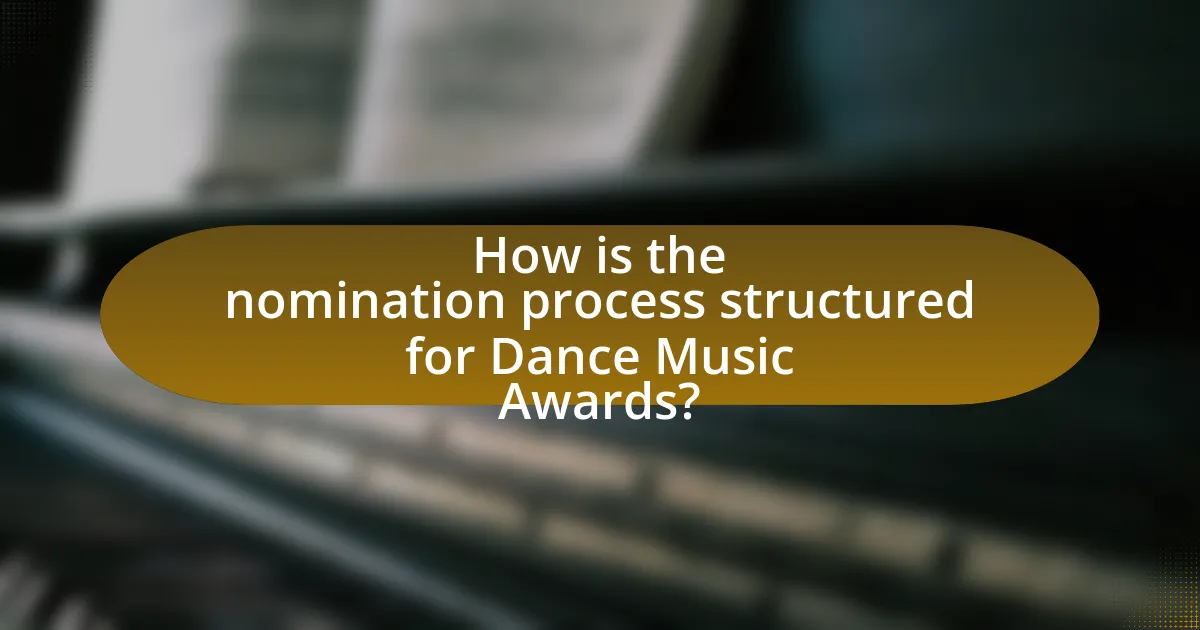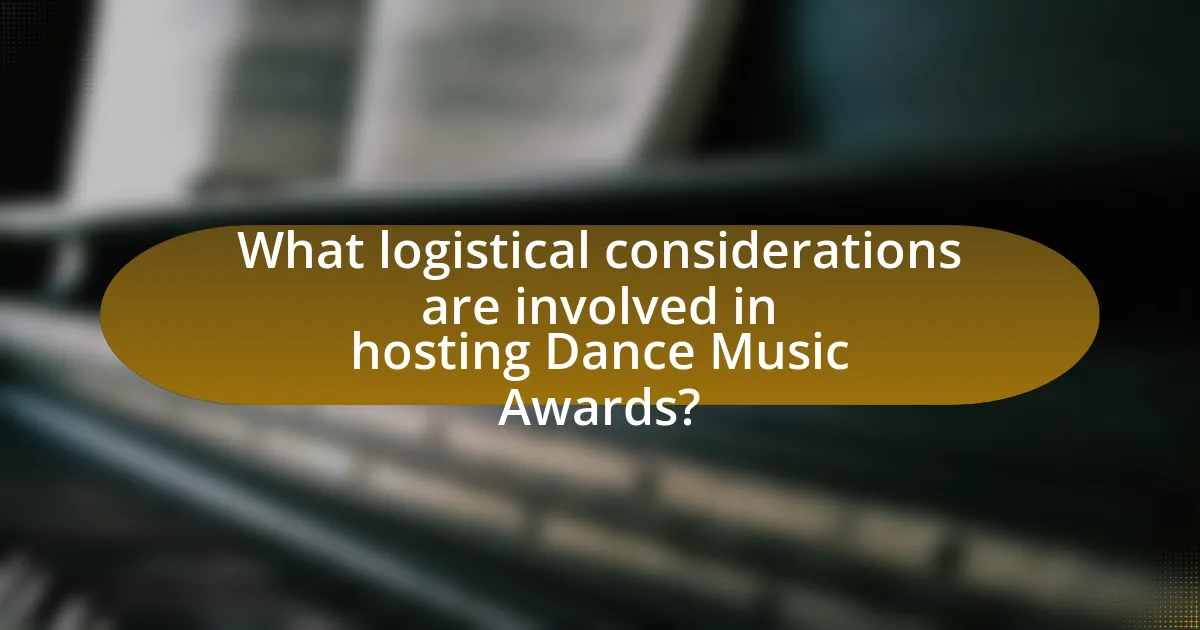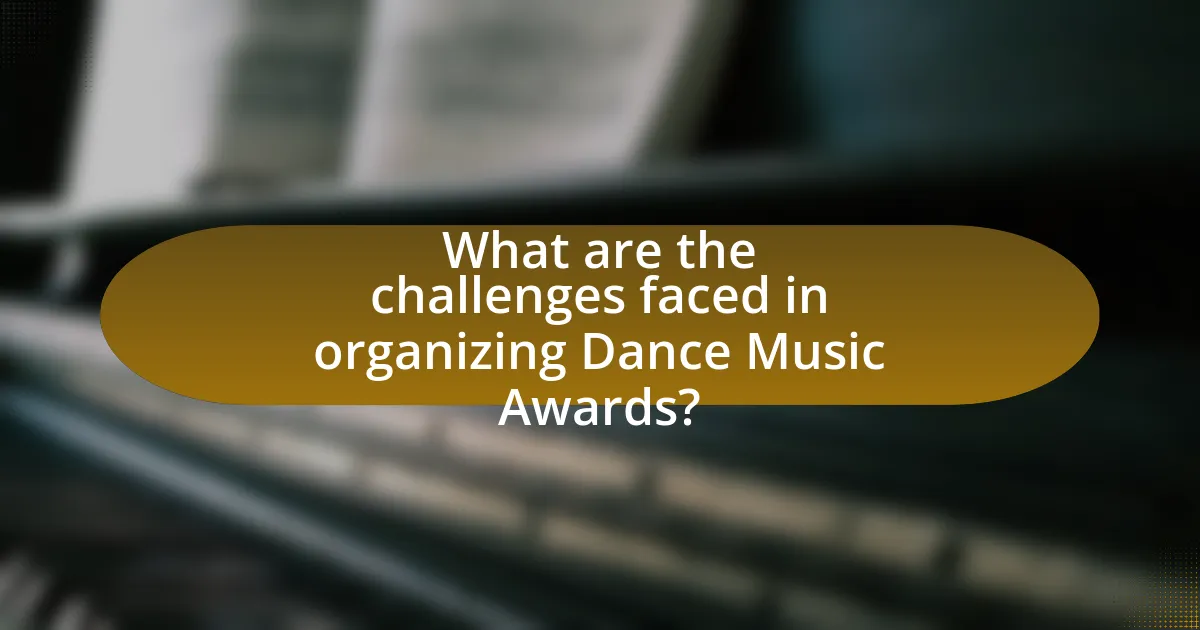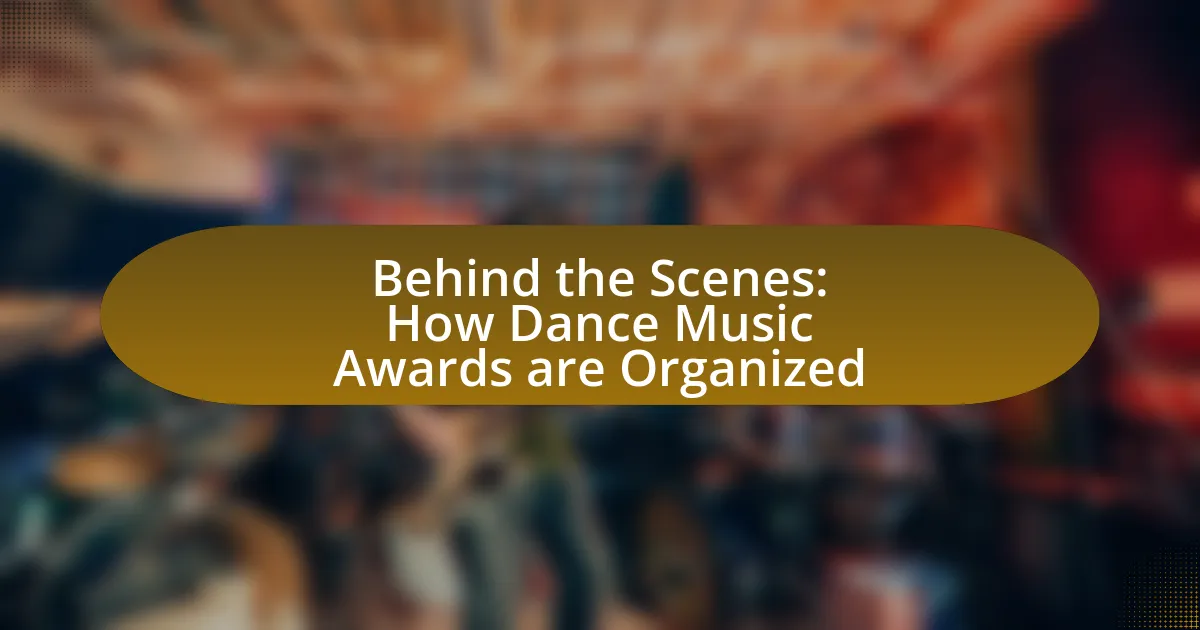Dance Music Awards are annual events that celebrate achievements in the electronic dance music (EDM) industry, recognizing artists, producers, and DJs while influencing industry trends and fan engagement. This article provides an in-depth look at the organization of these awards, detailing the nomination process, criteria for evaluation, and the roles of various stakeholders, including sponsors and fans. It also addresses logistical considerations, challenges faced during planning, and best practices for successful execution, highlighting the importance of effective communication and adaptability in a rapidly evolving music landscape.

What are Dance Music Awards and their significance?
Dance Music Awards are annual events that recognize and celebrate achievements in the electronic dance music (EDM) industry. Their significance lies in promoting artists, producers, and DJs, thereby enhancing their visibility and credibility within the music community. These awards often influence industry trends and fan engagement, as they highlight popular tracks, performances, and innovations in dance music. For instance, the International Dance Music Awards, established in 1985, have played a crucial role in shaping the careers of numerous artists by providing a platform for recognition and exposure.
How are Dance Music Awards different from other music awards?
Dance Music Awards differ from other music awards primarily in their focus on electronic dance music genres and the community surrounding them. Unlike traditional music awards that encompass a wide range of genres, Dance Music Awards specifically celebrate artists, producers, and DJs within the electronic dance music scene, which includes sub-genres like house, techno, and trance. This specialization allows for a more targeted recognition of contributions to the dance music culture, often involving fan voting and industry expert panels that reflect the unique dynamics of the electronic music community. For instance, the DJ Mag Top 100 DJs poll is a well-known example where fan engagement plays a crucial role in determining rankings, highlighting the interactive nature of Dance Music Awards compared to more conventional awards that may rely heavily on industry votes or sales figures.
What criteria are used to evaluate nominees for Dance Music Awards?
The criteria used to evaluate nominees for Dance Music Awards include artistic merit, innovation, popularity, and impact on the dance music scene. Artistic merit assesses the quality and creativity of the music, while innovation looks at how nominees push boundaries within the genre. Popularity is measured through metrics such as sales, streaming numbers, and fan engagement, reflecting the nominee’s reach and influence. Impact evaluates how the nominee has shaped or contributed to the dance music landscape, including collaborations and performances. These criteria ensure a comprehensive assessment of nominees, highlighting their contributions to the industry.
Why are Dance Music Awards important for artists and the industry?
Dance Music Awards are important for artists and the industry because they provide recognition and validation of talent, which can significantly enhance an artist’s career. Winning or being nominated for an award can lead to increased visibility, opportunities for collaboration, and higher demand for performances. Additionally, these awards help to establish industry standards and celebrate innovation within the genre, fostering a competitive environment that drives artistic growth. The impact of such recognition is evident, as artists often experience a boost in streaming numbers and social media engagement following award nominations or wins, demonstrating the tangible benefits of these accolades.
What are the key components involved in organizing Dance Music Awards?
The key components involved in organizing Dance Music Awards include venue selection, artist nominations, voting processes, sponsorship acquisition, and event promotion. Venue selection is crucial as it determines the capacity and atmosphere of the event, impacting attendee experience. Artist nominations involve a transparent process where industry professionals and fans can submit and vote for their favorite artists, ensuring representation of diverse talent. The voting process must be secure and accessible, often utilizing online platforms to facilitate participation. Sponsorship acquisition is essential for funding the event, requiring partnerships with brands that align with the dance music culture. Finally, event promotion through social media, press releases, and collaborations with influencers is vital to attract attendees and generate buzz, as evidenced by successful campaigns from previous awards that significantly increased ticket sales and viewership.
Who are the main stakeholders in the organization of Dance Music Awards?
The main stakeholders in the organization of Dance Music Awards include event organizers, sponsors, artists, and fans. Event organizers are responsible for planning and executing the awards, while sponsors provide financial support and resources. Artists are the nominees and performers, contributing to the event’s appeal, and fans play a crucial role by voting and attending, influencing the awards’ outcomes. Each stakeholder’s involvement is essential for the successful execution and popularity of the Dance Music Awards.
What roles do sponsors and partners play in the awards process?
Sponsors and partners play crucial roles in the awards process by providing financial support, resources, and promotional opportunities. Their contributions enable the organization of the event, covering costs such as venue rental, marketing, and production. For instance, sponsors often receive branding visibility through event materials and media coverage, which enhances their market presence. Additionally, partners may assist in logistics and outreach, ensuring a wider audience engagement. This collaboration not only elevates the awards’ profile but also fosters a mutually beneficial relationship, where sponsors gain recognition and the awards benefit from enhanced credibility and reach.

How is the nomination process structured for Dance Music Awards?
The nomination process for Dance Music Awards is structured through a combination of public voting and industry expert input. Initially, fans and the general public can submit their nominations for various categories, which are then reviewed by a panel of industry professionals who validate the entries based on specific criteria such as popularity, influence, and artistic merit. This dual approach ensures that both fan engagement and expert opinions shape the final list of nominees, reflecting a comprehensive view of the dance music landscape.
What steps are involved in the nomination process?
The nomination process for Dance Music Awards typically involves several key steps. First, eligible artists, tracks, or albums are identified based on specific criteria set by the award organizers. Next, a nomination committee reviews submissions and selects nominees based on their artistic merit and popularity. Following this, the nominees are announced publicly, allowing fans and industry professionals to recognize the contenders. Finally, voting takes place, where the public or a designated panel votes to determine the winners. This structured approach ensures a fair and transparent selection process, reflecting the preferences of both the audience and industry experts.
How are nominees selected and vetted for the awards?
Nominees for the awards are selected through a multi-step process that involves industry experts and public voting. Initially, a panel of judges, consisting of professionals from the dance music industry, reviews submissions and nominations based on criteria such as artistic merit, innovation, and impact. Following this, the nominees are further vetted through public voting, where fans can cast their votes for their favorite artists and tracks. This dual approach ensures that the nominees reflect both expert opinions and popular support, enhancing the credibility and relevance of the awards.
What role does public voting play in the nomination process?
Public voting serves as a critical mechanism in the nomination process for Dance Music Awards by allowing fans to directly influence which artists and tracks are recognized. This engagement not only democratizes the selection process but also reflects the preferences and trends within the dance music community. For instance, in many award shows, public voting accounts for a significant percentage of the total votes, ensuring that popular opinion is a key factor in determining nominees. This approach enhances transparency and encourages broader participation, ultimately fostering a stronger connection between artists and their audience.
How do organizers ensure transparency and fairness in the nominations?
Organizers ensure transparency and fairness in the nominations by implementing clear criteria and processes for candidate selection. They often publish detailed guidelines outlining eligibility requirements, nomination procedures, and evaluation criteria, which are accessible to all participants. Additionally, many organizers utilize independent panels or committees to review nominations, ensuring that decisions are made impartially. For instance, the use of anonymous voting systems can further reduce bias, as seen in various award ceremonies where votes are tallied by third-party auditors to maintain integrity. These practices collectively foster an environment of trust and accountability in the nomination process.
What measures are taken to prevent bias in the selection process?
To prevent bias in the selection process for Dance Music Awards, a combination of diverse judging panels, standardized evaluation criteria, and anonymous submissions is implemented. Diverse judging panels, which include members from various backgrounds and experiences, help ensure multiple perspectives are considered, reducing the likelihood of favoritism. Standardized evaluation criteria provide a uniform framework for assessing submissions, minimizing subjective interpretations. Additionally, anonymous submissions prevent judges from being influenced by the identity of the nominees, further promoting fairness. These measures collectively enhance the integrity of the selection process.
How is the integrity of the voting process maintained?
The integrity of the voting process is maintained through a combination of secure voting systems, transparency measures, and independent audits. Secure voting systems utilize encryption and authentication protocols to protect voter identities and ensure that votes are accurately counted. Transparency measures, such as publicly accessible voting records and clear communication of the voting process, allow stakeholders to verify the legitimacy of the results. Independent audits, conducted by third-party organizations, further validate the accuracy of the voting outcomes, ensuring that any discrepancies are identified and addressed. These practices collectively uphold the integrity of the voting process in the context of Dance Music Awards.

What logistical considerations are involved in hosting Dance Music Awards?
Hosting Dance Music Awards involves several logistical considerations, including venue selection, scheduling, and technical requirements. The venue must accommodate the expected audience size and provide necessary facilities, such as stages, sound systems, and lighting. Scheduling is critical to ensure that all performers, presenters, and award recipients are available, which often requires coordination with multiple stakeholders. Technical requirements include sound checks, video production, and live streaming capabilities to reach a broader audience. Additionally, security measures must be implemented to ensure the safety of attendees and participants, while transportation logistics for artists and equipment must be meticulously planned to avoid delays. These considerations are essential for a successful event, as evidenced by the complexity of organizing large-scale award shows in the entertainment industry.
How is the venue for the awards chosen and prepared?
The venue for the awards is chosen based on factors such as capacity, location, and suitability for the event’s theme. Event organizers assess various venues to ensure they can accommodate the expected number of attendees and provide the necessary facilities, such as staging, sound, and lighting. Preparation involves logistical planning, including layout design, seating arrangements, and technical setups, ensuring that all aspects align with the awards’ requirements and enhance the overall experience for participants and guests.
What factors influence the selection of the venue for Dance Music Awards?
The selection of the venue for Dance Music Awards is influenced by factors such as capacity, location, accessibility, and technical requirements. Capacity is crucial as it determines how many attendees can be accommodated, impacting ticket sales and overall atmosphere. Location plays a significant role in attracting participants and attendees, with venues in major cities often preferred for their visibility and accessibility. Accessibility includes considerations for transportation and accommodations for attendees, ensuring a smooth experience. Technical requirements involve the venue’s ability to support sound, lighting, and staging needs specific to dance music events, which are essential for delivering high-quality performances. These factors collectively ensure that the venue aligns with the event’s goals and enhances the overall experience for attendees and performers alike.
How do organizers manage technical requirements for the event?
Organizers manage technical requirements for the event by conducting thorough assessments of the venue’s capabilities and the specific needs of the event. They collaborate with technical teams to ensure that audio, visual, and lighting systems are compatible and meet industry standards. For instance, they often create detailed technical riders that outline equipment specifications and setup requirements, which are then communicated to vendors and technicians. This structured approach ensures that all technical aspects are addressed in advance, minimizing the risk of issues during the event.
What are the key elements of the event production for Dance Music Awards?
The key elements of event production for Dance Music Awards include venue selection, artist booking, technical setup, marketing and promotion, and audience engagement. Venue selection involves choosing a location that accommodates the expected audience size and provides necessary facilities. Artist booking requires securing popular DJs and performers to attract attendees. Technical setup encompasses sound, lighting, and stage design to create an immersive experience. Marketing and promotion are essential for generating buzz and ticket sales, often utilizing social media and partnerships. Audience engagement strategies, such as interactive experiences and merchandise, enhance attendee satisfaction and loyalty.
How is the event schedule developed and managed?
The event schedule for the Dance Music Awards is developed and managed through a collaborative process involving key stakeholders, including event organizers, venue managers, and artists. This process begins with identifying the event’s objectives and target audience, followed by drafting a preliminary schedule that outlines performance times, award presentations, and other activities.
Once the preliminary schedule is created, it undergoes revisions based on feedback from stakeholders to ensure logistical feasibility and alignment with the event’s goals. The finalized schedule is then communicated to all participants, including performers and presenters, to ensure everyone is informed of their roles and timings.
Management of the schedule continues up to the event date, with real-time adjustments made as necessary to accommodate unforeseen circumstances, such as delays or changes in artist availability. This dynamic approach ensures that the event runs smoothly and meets the expectations of attendees and participants alike.
What role do performers and presenters play in the awards ceremony?
Performers and presenters are essential to the awards ceremony as they enhance the entertainment value and facilitate the recognition of achievements. Performers deliver musical acts or performances that engage the audience, creating a celebratory atmosphere, while presenters announce award categories and winners, guiding the event’s flow and maintaining audience interest. Their roles are critical in ensuring that the ceremony is both enjoyable and organized, contributing to the overall success of the event.

What are the challenges faced in organizing Dance Music Awards?
Organizing Dance Music Awards presents several challenges, including securing sponsorships, managing logistics, and ensuring fair voting processes. Securing sponsorships is critical as financial backing is necessary for event execution; however, competition for sponsors in the entertainment industry can be intense. Managing logistics involves coordinating venues, sound equipment, and artist schedules, which requires meticulous planning and can lead to complications if not handled properly. Ensuring fair voting processes is essential for credibility; however, it can be difficult to implement transparent systems that prevent fraud and ensure that all votes are counted accurately. These challenges highlight the complexities involved in successfully organizing such events.
What common obstacles do organizers encounter during the planning process?
Organizers commonly encounter budget constraints during the planning process, which can limit resources and affect overall event quality. Additionally, logistical challenges such as venue availability and technical requirements often complicate the planning. According to a survey by Eventbrite, 40% of event organizers cite budget management as their primary obstacle, while 30% struggle with securing the right venue. These statistics highlight the significant impact of financial and logistical issues on the success of event planning.
How do budget constraints impact the organization of the awards?
Budget constraints significantly limit the resources available for organizing awards. These financial limitations can lead to reduced venue options, fewer promotional activities, and a smaller scale of the event overall. For instance, a limited budget may necessitate choosing a less expensive location, which can affect the event’s prestige and accessibility. Additionally, budget constraints often result in fewer awards being given or a reduction in the quality of awards, such as trophies or prizes. This can diminish the perceived value of the awards among participants and attendees, ultimately impacting engagement and attendance.
What strategies are employed to overcome logistical challenges?
To overcome logistical challenges in organizing dance music awards, event planners employ several strategies, including detailed planning, effective communication, and the use of technology. Detailed planning involves creating comprehensive timelines and checklists to ensure all aspects of the event are accounted for, which minimizes the risk of oversight. Effective communication among team members and stakeholders ensures that everyone is aligned on responsibilities and timelines, reducing misunderstandings that can lead to logistical issues. Additionally, leveraging technology, such as event management software, helps streamline processes like ticketing, scheduling, and resource allocation, thereby enhancing efficiency and coordination. These strategies are validated by industry practices that emphasize the importance of organization and communication in successful event management.
How do organizers adapt to changes in the music industry?
Organizers adapt to changes in the music industry by implementing innovative strategies and leveraging technology to enhance audience engagement and streamline event logistics. For instance, they utilize data analytics to understand audience preferences and adjust programming accordingly, ensuring that lineups reflect current trends. Additionally, organizers increasingly incorporate digital platforms for ticket sales and virtual experiences, as evidenced by the rise of live-streamed events during the COVID-19 pandemic, which allowed for broader audience reach and engagement. This adaptability is crucial for maintaining relevance and profitability in a rapidly evolving industry landscape.
What trends are influencing the future of Dance Music Awards?
The future of Dance Music Awards is being influenced by trends such as the rise of digital voting platforms, increased focus on diversity and inclusion, and the integration of virtual reality experiences. Digital voting platforms enhance accessibility and engagement, allowing a broader audience to participate in the awards process. The emphasis on diversity and inclusion reflects a growing recognition of the need for representation across various demographics within the dance music community. Additionally, the incorporation of virtual reality experiences offers innovative ways for fans to engage with the awards, creating immersive environments that enhance the overall experience. These trends are reshaping how the awards are organized and perceived, aligning with the evolving landscape of the music industry.
How do organizers incorporate feedback from previous events?
Organizers incorporate feedback from previous events by systematically collecting and analyzing participant responses through surveys and focus groups. This process allows them to identify strengths and weaknesses in event execution, such as venue selection, scheduling, and artist lineups. For instance, a study by Eventbrite found that 70% of event organizers who utilized attendee feedback reported improved satisfaction in subsequent events. By implementing changes based on this feedback, organizers can enhance the overall experience, ensuring that future events align more closely with attendee expectations and preferences.
What best practices can be applied to successfully organize Dance Music Awards?
To successfully organize Dance Music Awards, it is essential to establish a clear framework that includes defining categories, engaging stakeholders, and ensuring effective marketing. Defining categories allows for a structured approach to recognize various talents and contributions within the dance music industry, which can enhance participation and audience interest. Engaging stakeholders, such as artists, sponsors, and fans, fosters a sense of community and investment in the event, leading to increased support and attendance. Effective marketing strategies, including social media campaigns and partnerships with influencers, can significantly boost visibility and ticket sales, as evidenced by the success of events like the DJ Mag Top 100 DJs poll, which utilizes extensive online engagement to drive participation.
How can effective communication enhance the organization process?
Effective communication enhances the organization process by ensuring clarity, reducing misunderstandings, and fostering collaboration among team members. When communication is clear, all participants understand their roles and responsibilities, which streamlines workflows and increases efficiency. Research indicates that organizations with effective communication practices experience a 25% increase in productivity, as employees are more engaged and informed about their tasks. This clarity also minimizes errors and delays, ultimately leading to a smoother organizational process.
What lessons can be learned from past Dance Music Awards events?
Past Dance Music Awards events reveal several key lessons regarding organization and audience engagement. Firstly, effective communication with nominees and attendees is crucial; clear guidelines and timely updates enhance participant experience. For instance, the 2020 awards faced criticism due to last-minute changes, highlighting the need for transparency. Secondly, leveraging social media for promotion and audience interaction has proven beneficial; events that utilized platforms like Instagram and Twitter saw increased engagement and attendance. The 2019 awards, which incorporated live social media updates, reported a 30% rise in viewer interaction compared to previous years. Lastly, recognizing and adapting to industry trends, such as the rise of digital streaming, is essential for relevance; the 2021 awards successfully integrated virtual performances, attracting a broader audience. These lessons underscore the importance of communication, social media engagement, and adaptability in organizing successful Dance Music Awards events.
